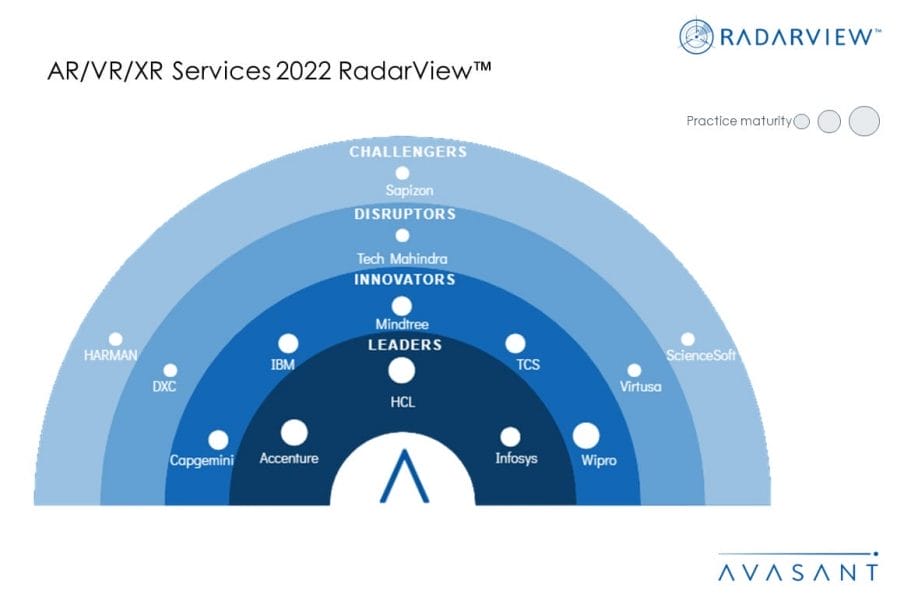Augmented reality (AR), virtual reality (VR), and extended reality (XR) have not yet been adopted at scale. However, businesses are starting to realize the opportunities they can unlock with AR/VR/XR. Enterprise digital leaders are deploying AR/VR/XR with the goal of creating more immersive experiences for employees and customers, enhancing data visualization, and improving manufacturing and maintenance processes. Nevertheless, high device and implementation costs remain prime hurdles for enterprise digital transformation engagements.
These trends, and others, are covered in our AR/VR/XR Services 2022 RadarView™. The report is a comprehensive study of AR/VR/XR service providers, featuring top trends, analysis, and recommendations. It takes a close look at the market’s leaders, innovators, disruptors, and challengers.
We evaluated 42 service providers across three dimensions: practice maturity, partner ecosystem, and investments and innovation. Of those, 14 were recognized for bringing the most value to the market over the last 12 months.
The report recognizes service providers in four categories:
-
- Leaders: Accenture, HCL, and Infosys
- Innovators: Capgemini, IBM, Mindtree, TCS, and Wipro
- Disruptors: DXC, Tech Mahindra, and Virtusa
- Challengers: HARMAN, Sapizon, and ScienceSoft
Figure 1 from the full report illustrates these categories:

“Immersive technologies have emerged as one of the core pillars of Industry 4.0,” said Anupam Govil, partner and digital practice lead at Avasant. “The possibilities in smart manufacturing continue to expand from product prototyping to quality control as the technology becomes more intuitive and accessible for businesses to implement on a large scale.”
The full report provides a number of findings and recommendations, including the following:
-
- About 65% of AR/VR/XR projects in the proof of concept and pilot phases and user trials are on the path for immersive technologies to go into production over the next 12–18 months. Retail, manufacturing and automotive, and healthcare industries are leading production-grade implementations, primarily for remote training, customer assistance, product design, and expert collaboration. More complex applications (urban planning and virtual transactions) will emerge as the technology matures.
- 3D data visualization and analysis across IoT, digital twins, and big data will improve using AR/VR/XR. 3D visualizations will understand and recognize trends and patterns that may not be immediately visible with 2D visualizations. Convergence of AI, blockchain, cloud, and 5G connections with AR/VR/XR will enhance cognition, security, user experience, and speed.
- The demand for a more intuitive and seamless human-machine remote experience and Facebook’s name change to Meta has led to a boom in potential use cases for the metaverse. Metaverse has gained outsized attention over standalone AR/VR/XR implementations. Previous standalone AR/VR/XR skills are not a prerequisite for using AR/VR in the metaverse. About 60% of enterprises have not adopted AR/VR/XR yet and are expected to jump on the metaverse bandwagon with early movers in the banking, real estate, and retail industries.
“The enterprise response to COVID-19 has accelerated transformation in remote collaboration and communication” said Chandrika Dutt, research leader at Avasant. “In the next wave of evolution, Digital Workplace 2.0, enterprise focus should be on augmenting employee experience and creating a secure work environment in high-risk sectors using AR/VR/XR.”
The full report also features detailed RadarView profiles of 14 service providers, along with their solutions, offerings, and experience in assisting enterprises in their AR/VR/XR transformation journeys.
This Research Byte is a brief overview of the AR/VR/XR Services 2022 RadarView™ (click for pricing).




